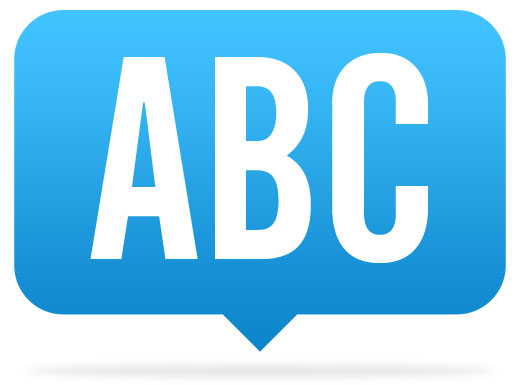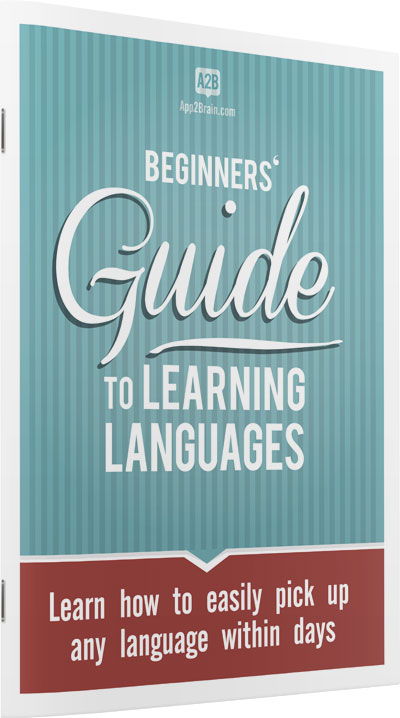German is one of the most widely spread languages with almost 100 million native speakers worldwide – and even though it is a Germanic language, it uses the Latin alphabet as its writing system.
This lesson is part of the chapter “Learning German“.

Introduction
Most of you will be familiar with this alphabet since it’s the most popular. Germanic languages decided to abandon their previous Runic and Gothic alphabets to make room for the Latin alphabet with the spread of Christianity during the middle ages.
This spread of the Latin alphabet in the Germanic world happened thanks to Charlemagne, who wanted German to have an established writing system. Although Latin was the written language by default, the first texts written in German began appearing during eighth century. The language and its written form kept evolving until it was standardized and nowadays we can find a Latin alphabet adapted to the needs of the German language.
You will be familiar with almost all of these letters, but we’ll show you how to use and pronounce them in German!
The German Alphabet
| Letter (lower case) | Letter (upper case) | Pronunciation | Example | Audio |
|---|---|---|---|---|
| a | A | ah | Mann (man) | |
| b | B | bey | Buch (book) | |
| c | C | tsay | Cent (cent) | |
| d | D | day | Dorf (village) | |
| e | E | ay | Bett (bed) | |
| f | F | eff | finden (to find) | |
| g | G | gay | geben (to give) | |
| h | H | hah | Haus (house) | |
| i | I | ee | Igel (hedgehog) | |
| j | J | yawt | ja (yes) | |
| k | K | kah | kalt (cold) | |
| l | L | ell | Lied (song) | |
| m | M | emm | Maus (mouse) | |
| n | N | enn | nein (no) | |
| o | O | oh | offen (open) | |
| p | P | pay | Park (park) | |
| q | Q | koo | Quiz (quiz) | |
| r | R | err | Reis (rice) | |
| s | S | ess | Socke (sock) | |
| t | T | tay | Tee (tea) | |
| u | U | oo | unter (under, below) | |
| v | V | fow | Vater (father) | |
| w | W | vay | Wagen (car) | |
| x | X | ix | Taxi (taxi) | |
| y | Y | üpsilon | physisch (physical) | |
| z | Z | tset | Zimmer (room) |
Special characters
| Letter (lower case) | Letter (upper case) | Pronunciation | English transcription (lower case) | English transcription (upper case) | Example | Audio |
|---|---|---|---|---|---|---|
| ß | – | eszett/scharfes s (sharp s) | ss | – | Straße (street) | |
| ä | Ä | ay | ae | Ae | spät (late) | |
| ö | Ö | er | oe | Oe | hören (to hear) | |
| ü | Ü | ue | ue | Ue | über (over) |
Consonant combinations
Let’s take a look at some consonant combinations since these consonants make a different sound together as opposed to a single consonant, this way you won’t have a problem when you find them!
| Consonant Combination | Pronunciation |
|---|---|
| ch | This can be pronounced in different ways depending on the word and the vowels. It’s very important to know that the pronunciation of the ich and ach sounds do not exist in English. In the case of the “ich-sound” (which is the same sound as in ig), resembles the English h in “huge”, but more powerful, it’s the sound of the friction of the air at the back of the throat. The “ach-sound” is guttural, similar like the sound you make while clearing your throat, it’s used after a, o and u. Other combinations with ch include chs which in the middle or end of the word is pronounced like the English x. If it’s sch, it’s pronounced like sh. The ch at the start of the words varies, it could be pronounced like the “ich-sound” or like a k in some variations. |
| ck | Pronounced like in English. |
| pf | Both letters have to be pronounced. |
| sp and st | The s is pronounced like sh, followed by p or t respectively. |
| th | Pronounced like a t. |
| tsch, zsch, tzsch | Pronounced like the English combination of ch. |
| tz | Pronounced like ts. |
| dt | Pronounced like t. |
Vowel combinations
Same goes with the following vowel combinations.
| Vowel Combination | Pronunciation |
|---|---|
| aa | Pronounced like a long ah. |
| au | Pronounced like ow. |
| äu and eu | Pronounced as oi. |
| Ei, ai, ey and ay | Pronounced as in eye. |
| ee | Is the long ay sound. |
| ie | Is pronounced ee. |
| oo | Is the long oh. |
Pronunciation
| Letter (lower case) | Pronunciation | Phonetic notation |
|---|---|---|
| a | car | short: [a]; long: [aː] |
| b | book | [b]; [p] at the end of the syllable |
| c | similar to cats; computer | [ts] before e, i, y, ä, ö; otherwise [k] |
| d | dad | [d]; like [t] at the end of the syllable |
| e | bed | short:[ɛ], [ə]; long: [e] |
| f | find | [f] |
| g | give | [g]; [k] at the end of the syllable; [ç] when the word ends in -ig |
| h | house | [h]; silent if it’s after a vowel (lengthens the vowel) |
| i | keep | short: [ɪ]; long: [i] |
| j | yard | [j] |
| k | kick | [k] |
| l | left | [l] |
| m | mouse | [m] |
| n | noon | [n] |
| o | offer | short: [ɔ]; long: [o] |
| p | park | [p] |
| q | quick | [kv] |
| r | Guttural [ʁ] at the beginning of the word, [ɐ] at the end (specially in -er); rolled [r] in some variations of the language | rolled [r] |
| s | zebra | [z] at the beginning of the word and between vowels; [s] before consonants and at the end; [ʃ] before p or t |
| t | tea | [t] |
| u | moon | short: [ʊ]; long: [u] |
| v | similar to either German f or w | [f]; [v] in loanwords |
| w | valley | [v] |
| x | taxi | [ks] |
| y | lyrics | [y]; [ɪ]; [ʏ]; [j] |
| z | No real equivalent in English; ts sound, like the c | [ts] |
Special characters
| Letter (lower case) | Pronunciation | Phonetic notation |
|---|---|---|
| ß | less | [s]; lengthens the vowel that precedes it |
| ä | air | [eː], [ɛː] |
| ö | No equivalent in English; sounds like the e in her or the u in turn; this sound is made by pursing the lips and pronouncing an e | [ø]; [øː]; [œ] |
| ü | No equivalent in English; this sound is made by pursing the lips and pronouncing an o | [ʏ]; [y] |
HTML and Unicode
| Letter (lower case) | HTML code (lower case) | HTML code (upper case) | Unicode (lower case) | Unicode (upper case) |
|---|---|---|---|---|
| a | #97 | #65 | U+0061 | U+0041 |
| b | #98 | #66 | U+0062 | U+0042 |
| c | #99 | #67 | U+0063 | U+0043 |
| d | #100 | #68 | U+0064 | U+0044 |
| e | #101 | #69 | U+0065 | U+0045 |
| f | #102 | #70 | U+0066 | U+0046 |
| g | #103 | #71 | U+0067 | U+0047 |
| h | #104 | #72 | U+0068 | U+0048 |
| i | #105 | #73 | U+0069 | U+0049 |
| j | #106 | #74 | U+006A | U+004A |
| k | #107 | #75 | U+006B | U+004B |
| l | #108 | #76 | U+006C | U+004C |
| m | #109 | #77 | U+006D | U+004D |
| n | #110 | #78 | U+006E | U+004E |
| o | #111 | #79 | U+006F | U+004F |
| p | #112 | #80 | U+0070 | U+0050 |
| q | #113 | #81 | U+0071 | U+0051 |
| r | #114 | #82 | U+0072 | U+0052 |
| s | #115 | #83 | U+0073 | U+0053 |
| t | #116 | #84 | U+0074 | U+0054 |
| u | #117 | #85 | U+0075 | U+0055 |
| v | #118 | #86 | U+0076 | U+0056 |
| w | #119 | #87 | U+0077 | U+0057 |
| x | #120 | #88 | U+0078 | U+0058 |
| y | #121 | #89 | U+0079 | U+0059 |
| z | #122 | #90 | U+007A | U+005A |
Special characters
| Letter (lower case) | HTML code (lower case) | HTML code (upper case) | Unicode (lower case) | Unicode (upper case) |
|---|---|---|---|---|
| ß | #223 (szlig) | – | U+00DF | – |
| ä | #228 (auml) | #196 (Auml) | U+00E4 | U+00C4 |
| ö | #246 (ouml) | #214 (Ouml) | U+00F6 | U+00D6 |
| ü | #252 (uuml) | #220 (Uuml) | U+00FC | U+00DC |

Download your free language learning guide
Our free 18-page PDF ebook will teach you how to:
- Get (and stay) motivated learning a new language
- Achieve 80% of your goals with only 20% of the effort
- Make your learning experience more fun than ever
Leave A Comment